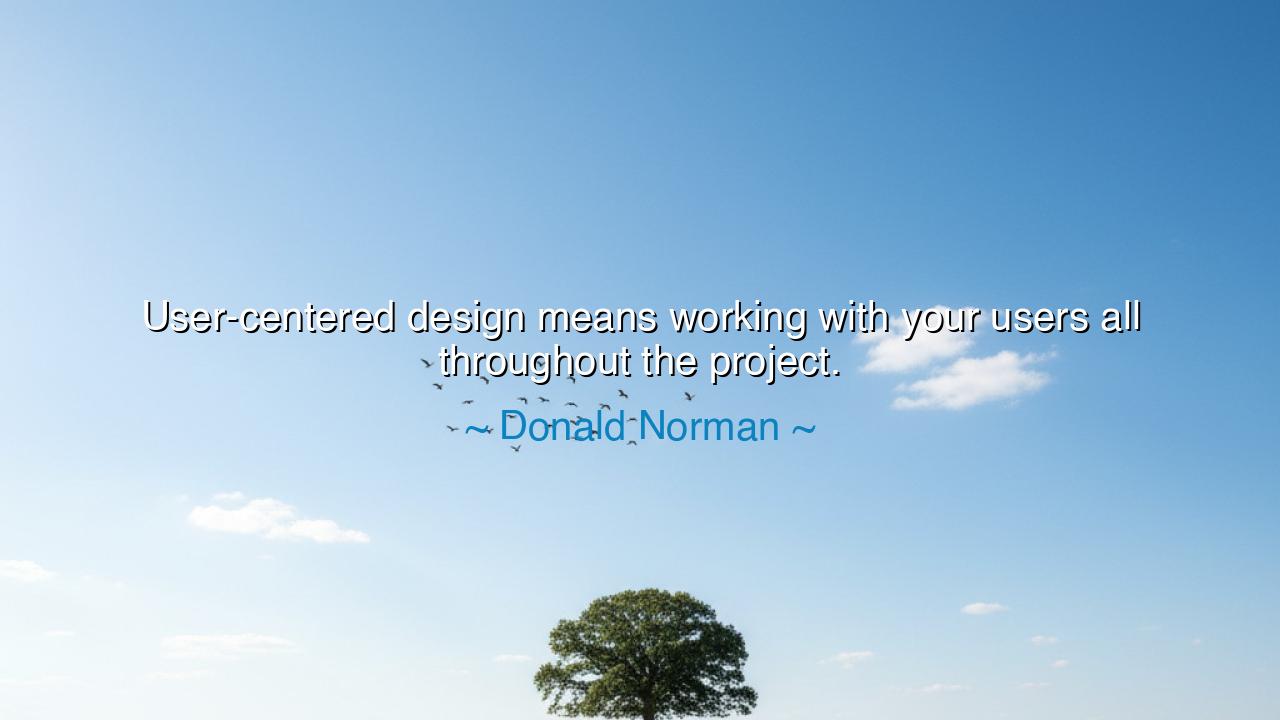
User-centered design means working with your users all throughout






When Donald Norman, the sage of design philosophy, declared, “User-centered design means working with your users all throughout the project,” he was not speaking merely of method or practice — he was speaking of respect. For in those words lies a truth as old as creation itself: that to build something meaningful, one must first listen. Norman, a pioneer of human-centered thinking, saw that too often designers shaped tools, systems, and experiences not for people, but for their own pride. His teaching was a reminder that the heart of all creation — whether in art, architecture, or technology — is the human being who will live with what we make.
To understand his wisdom, one must first grasp what he meant by user-centered design. In Norman’s world, the designer is not a master dictating form and function from above, but a servant of human needs, a translator between the mind and the material. To work “with your users” means not to guess what they want, nor to impose what you think is best, but to walk beside them, to learn from their struggles, their habits, their joys and frustrations. It means inviting them into the process — from the first spark of an idea to the final moment of release — so that what is created does not simply work, but belongs.
Such a philosophy did not arise in isolation. Norman, whose work with Apple and in cognitive science reshaped modern design, drew from a truth that echoes through all great endeavors: that empathy is the cornerstone of wisdom. In ancient times, the builders of cathedrals walked among the people who would pray beneath their arches. The sculptors carved saints and symbols that spoke to the hearts of the faithful, not to the vanity of the artist. The greatest works of the Renaissance were born not from isolation, but from understanding — Michelangelo spoke of releasing the form that already lived within the stone, just as Norman speaks of uncovering the design that already lives within the user’s experience.
Consider the story of the Oxo Good Grips kitchen utensils — simple tools that transformed daily life. The creator, Sam Farber, designed them not for fashion or profit, but for his wife, whose arthritis made ordinary handles painful to hold. In her struggle, he saw a universal need: that design should serve the body, not fight it. With soft grips, ergonomic shapes, and patient testing, he crafted objects that were gentle to the hand yet strong in purpose. His success was not an accident — it was user-centered design made flesh. In that humble act of listening, he gave dignity to millions.
Norman’s quote is not a commandment to engineers alone; it is a moral philosophy. It asks us all — in every craft, in every act of creation — to turn our gaze outward. To make anything of worth, be it a product, a poem, or a life, we must live in dialogue with others. When we create without listening, our work becomes brittle, beautiful perhaps, but cold. But when we create with others — learning from their stories, inviting their insight, embracing their needs — our work becomes alive. It carries the warmth of shared humanity.
There is also humility in Norman’s words. To “work with your users all throughout the project” means accepting that one’s first idea is rarely perfect, that iteration — the slow, patient refining of form — is not failure, but devotion. It means being willing to be wrong, to be taught, to be changed by those for whom you design. The ancient philosophers called this teachability, the readiness to learn even from the simplest soul. In design, as in life, this humility is the seed of greatness.
So, O creator of worlds and maker of things, take this teaching into your hands: listen deeply before you build. Seek to understand before you seek to impress. In your work, let every choice reflect the lives of those it will touch. Speak not for your users — speak with them. Walk beside them through every trial of creation, until your work bears not only your signature, but their spirit as well.
For when you design in this way — not as a ruler over others, but as a companion in their journey — your work will transcend function. It will become human, and therefore timeless. For the truest designs, like the truest lives, are those shaped not by ego, but by empathy, and guided, as Donald Norman taught, by the simple, eternal wisdom of working with those you serve — all throughout the project, and beyond.






AAdministratorAdministrator
Welcome, honored guests. Please leave a comment, we will respond soon